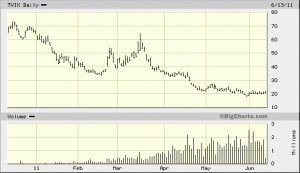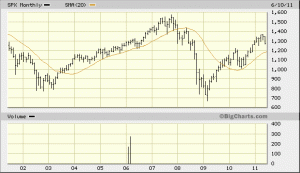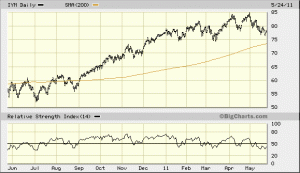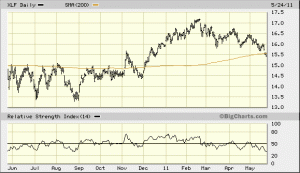Markets Still Soft As QE2 Winds Down
With only a couple weeks of QE2 remaining the S&P 500 ETF appears to be headed to test the 200 day moving average in the $125 area (1250 S&P Index). The bullish commodity trade that ran wild after the initiation of QE2 also appears to be deflating as one by one the commodity ETFs roll over lead by Silver and now joined by the agricultural commodity etf and Coal ETF.
The fact that we are in summer also adds to the doldrums with many investors taking the “Sell In May” approach. This approach looked particularly attractive to me this year, so I’m holding a 30% cash position at the moment. If the S&P 500 holds at 1250 I may cut that cash in half, but it doesn’t feel like we are at a stock market bottom.
The strangest thing about the decline thus far is the total lack of volatility that has accompanied it. This makes me believe there might be something bigger on the horizon. Volatility ETF volume continues to swell as investors seek protection, but volatility has remained very subdued. Normally things don’t turn around until after you have a significant spike in volatility and inject some fear into the market.
Looking at the Leveraged Volatility ETF below you can see that the deflation of volatility has be a very persistent trend over the past 6 months.
If the 200 day moving average fails to contain the market, the major support comes in at the 20 Month SMA which is currently at roughly 1185-1190. As you can see in the following chart this average is tested most years in the summer time, with all the headwinds in the market it would not be surprising to see a test this year as well.
A drop into the 1185-1190 area that was accompanied by a nice spike in volatility would set up a perfect buying scenario. It might also be a good time to buy a leveraged financial etf since the financials are one of the most beaten down sectors in the market. Oil services is another area that might be appealing again if it takes part in the sell off.
In the meantime, I don’t think there is any rush to buy stock as the negatives (Greece,End Of QE2 etc) far outweigh the fact that the market is 7 1/2% cheaper than the recent peak.




